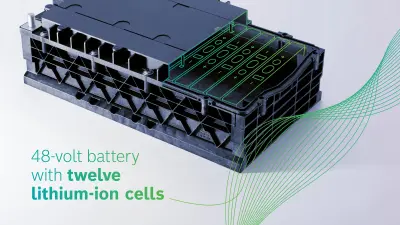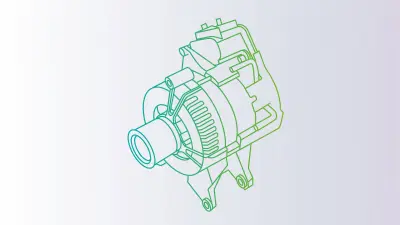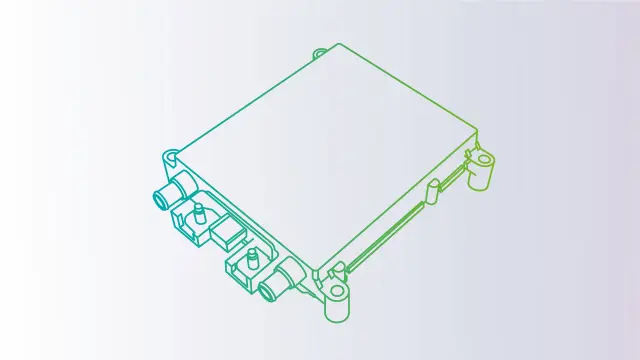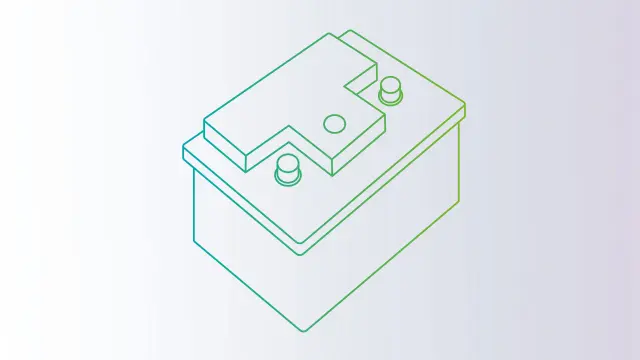Ready for a reVOL(T)ution?
Then listen up! Here comes Bosch’s 48-volt battery for hybrids

No larger than a shoebox, this battery is set to have a huge impact on vehicle electrification. So here’s everything you need to know about the 48-volt battery, explained in 48 points.
1. At some point in the near future, a number of automakers intend to switch over to producing nothing but electrified cars. For many of these electrified vehicles, however, the internal combustion engine will remain the primary powertrain.
2. That may sound like a contradiction, but it isn’t.
3. New emissions guidelines are the driving force behind increasing electrification. In a move to reduce the combined CO₂ emissions of their vehicle fleets, automakers are turning to a variety of technical solutions.
4. One of these is the 48-volt hybrid system for vehicles equipped with an internal combustion engine.
5. There are different types of 48-volt systems which enable a wide variety of different vehicle functions, from boosting engine performance to supplying the growing number of electrical consumers to powering functions such as parking aids. The one thing they all have in common is a 48-volt battery.

6. The 48-volt battery is therefore the core component of mild hybrids. It powers — and is charged by — a combined starter-generator that can, for example, be integrated into the internal combustion engine’s conventional belt-driven generator. A direct current converter (DC-DC) converts the voltage from the 48-volt battery to the 12 volts required for the vehicle’s electrical system.
7. Among this system’s many benefits is its cost-effectiveness, since it can be integrated relatively easily within existing vehicle concepts.
8. The favorable cost-benefit ratio of this technology means it has big potential. Bosch predicts that the annual share of new passenger cars and light commercial vehicles equipped with 48-volt systems will rise from 5 to 20 percent between 2020 and 2025.

9. The key virtue of the 48-volt battery is the contribution it makes toward reducing CO₂ emissions. And this benefits not only automakers, but also drivers, since lower carbon emissions means lower fuel consumption.
10. These savings come essentially from a recuperation of the energy that normally dissipates as heat when the vehicle brakes. Instead, this energy is now used to drive a generator that replenishes the 48-volt battery with power.
11. This power is used in two ways: to supply the vehicle’s electrical system and to provide, via the combined starter-generator, additional torque that is then used to propel the vehicle.
12. In other words, the 48-volt battery lightens the engine’s workload and thereby cuts fuel consumption.
13. Further fuel savings and cuts in CO₂ emissions can be achieved through the incorporation of start-stop systems.
14. At the same time, a 48-volt battery enables the use of energy consumers that offer enhanced comfort but consume significantly more power, such as electrically controlled stabilizers to counteract vehicle roll.
15. The coming generation of vehicles will rely heavily on 48-volt systems. This is because a higher voltage is required to generate the power necessary to supply the processors that control highly automated systems.

16. We’re nearly halfway through our list of 48 steps. It’s therefore time to take stock and focus on three points in particular.
17. The 48-volt battery is the core component of mild hybrids. It provides a power boost for the internal combustion engine and thereby helps reduce CO₂ emissions.
18. It delivers a vehicle that is, above all, efficient and comfortable to drive.
19. It offers a cost-effective route to electrification that benefits not only automakers but also drivers.
20. So the only remaining question is: where’s the downside?
21. The 48-volt battery’s advantages are legion, but one constraint could be a deal-breaker: it is yet another component to be accommodated within a complex vehicle architecture, where space is at a premium and every extra millimeter and gram are critical.
22. Here, too, Bosch’s 48-volt battery offers an ideal solution. Its compact dimensions offer maximum flexibility when deciding where it is to be installed.
23. A mere 90 millimeters high, it can be stowed away in the trunk, for example, or under the passenger seat.
24. The picture below gives an idea of the battery height.

26. Its compact design is the result of some smart engineering where thermal management is concerned.
27. Together with suppliers, Bosch spent four years developing a new type of lithium-ion battery cell that dispenses with conventional cooling methods. This delivers a number of crucial advantages.
28. On account of their high power density, lithium-ion cells can get very hot. In order to prevent any damage, conventional cells automatically reduce their output as soon as temperatures of 55–60 degrees Celsius are reached.
29. However, the cells in Bosch’s battery are made of sterner stuff. They work at temperatures up to 75 degrees.
30. Thanks to their greater tolerance to heat, the Bosch cells require a less complex cooling method.
31. In concrete terms, this means that the Bosch battery gets by without an active cooling system based on either liquid or air as a coolant.
32. Instead, it makes use of what’s known as passive cooling, which exploits heat sinks in the immediate vicinity of wherever the battery is installed, thereby ensuring a sufficient dissipation of heat during and after battery operation.

33. Since passive cooling works without any additional components or connections, this not only reduces the space required for installation but also cuts costs and weight.
34. Given its greater technical complexity, the choice of an active cooling system, whether with air or liquid, generates extra costs for the battery and vehicle. By contrast, passive cooling reduces overall system costs.
35. Furthermore, at a weight of under six kilograms, the Bosch 48-volt battery is between one and two kilos lighter than a battery with active cooling.
36. And here’s another benefit to consider: with conventional batteries, part of the energy recuperated during braking is siphoned off to power the cooling system. But with passive cooling, all the energy recovered in this way can be used to boost engine performance and thus reduce CO₂ emissions.
37. What’s more, passive cooling means no fan noise, which means that the 48-volt battery operates almost silently.
38. The Bosch 48-volt battery delivers all these benefits in an extremely compact package: 309 millimeters long, 175 millimeters wide, and — as mentioned above — a mere 90 millimeters in height.
39. In other words, no bigger than a shoebox.
40. And not a Bigfoot-sized shoebox, but one that would comfortably accommodate a European size…

42. Integral to the overall design of the 48-volt battery is its plastic housing.
43. This protects against damage from the outside and is also robust enough to withstand the continual expansion and contraction of the cells that occurs during charging and discharging throughout the battery’s service life.
44. This choice of housing brings other advantages, too. Plastic not only cuts costs; it can also be molded into complex forms that facilitate the integration of added functionality.
45. Bosch’s 48-volt battery perfectly illustrates the marketing adage that it’s not just what’s inside that counts — packaging matters too.
46. Besides, it also shows that a smart solution for cutting CO2 can come in a plastic housing with the dimensions of a shoebox that is no higher than a small action figure!
47. That leaves just one more question: when will the product be market-ready?
48. In fact, production already started in late 2018, in China. That’s where the market for vehicles with 48-volt electrical systems is currently growing faster than anywhere else.






